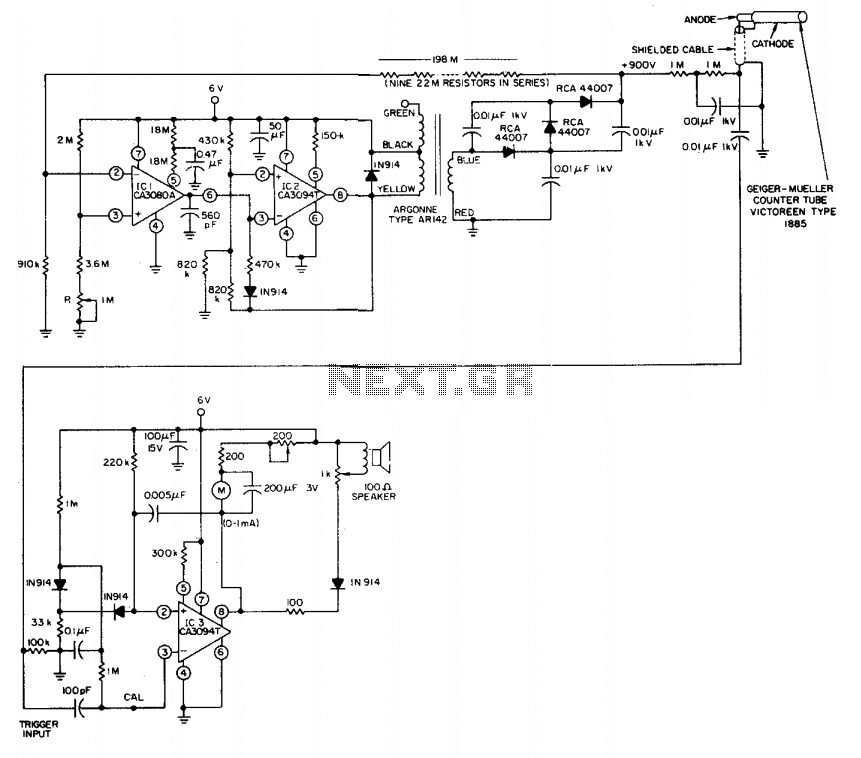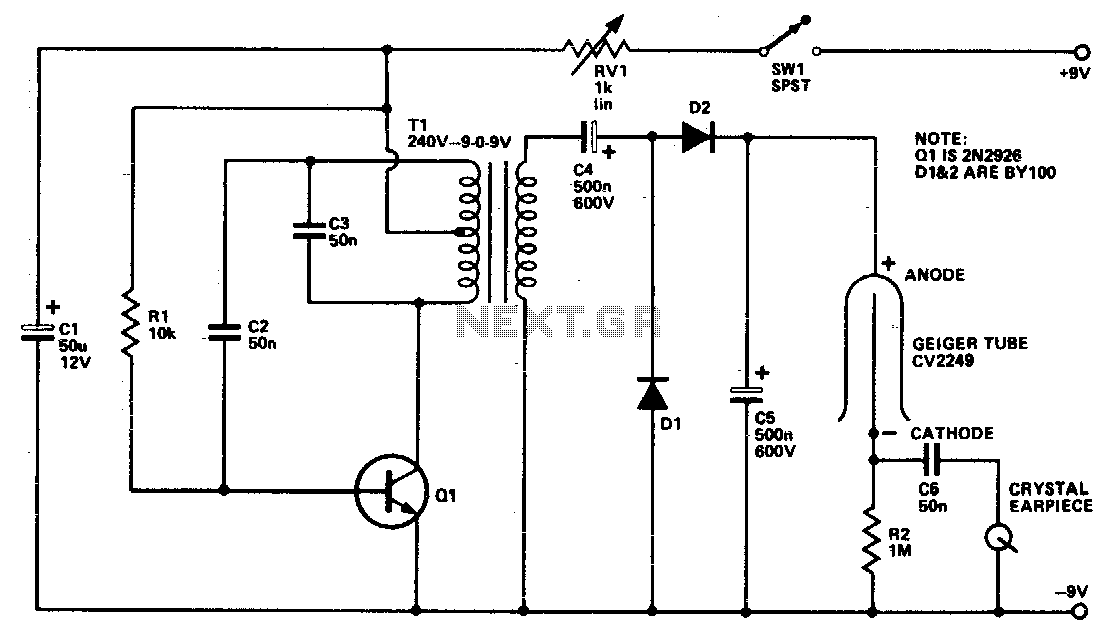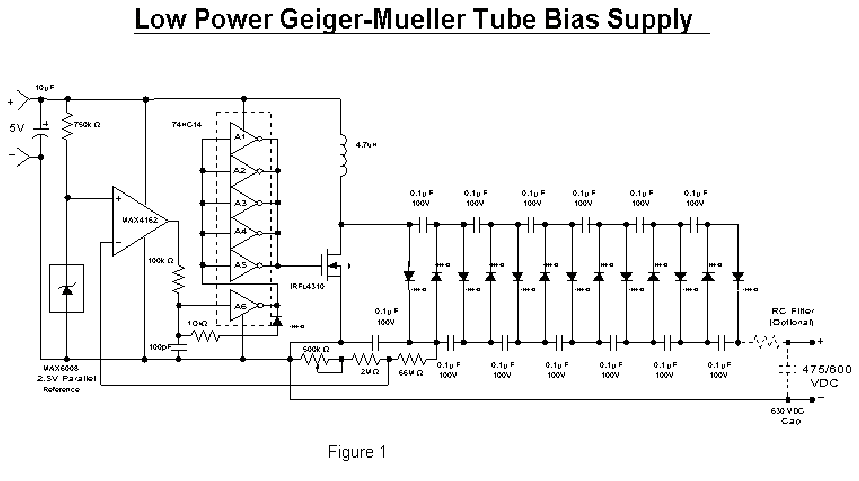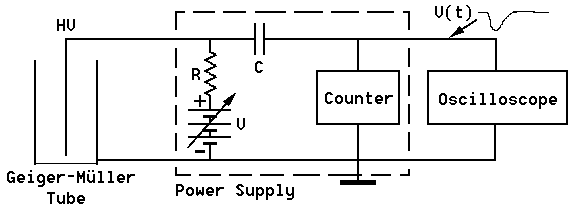
DIY/Homemade Geiger Muller Clicker V1
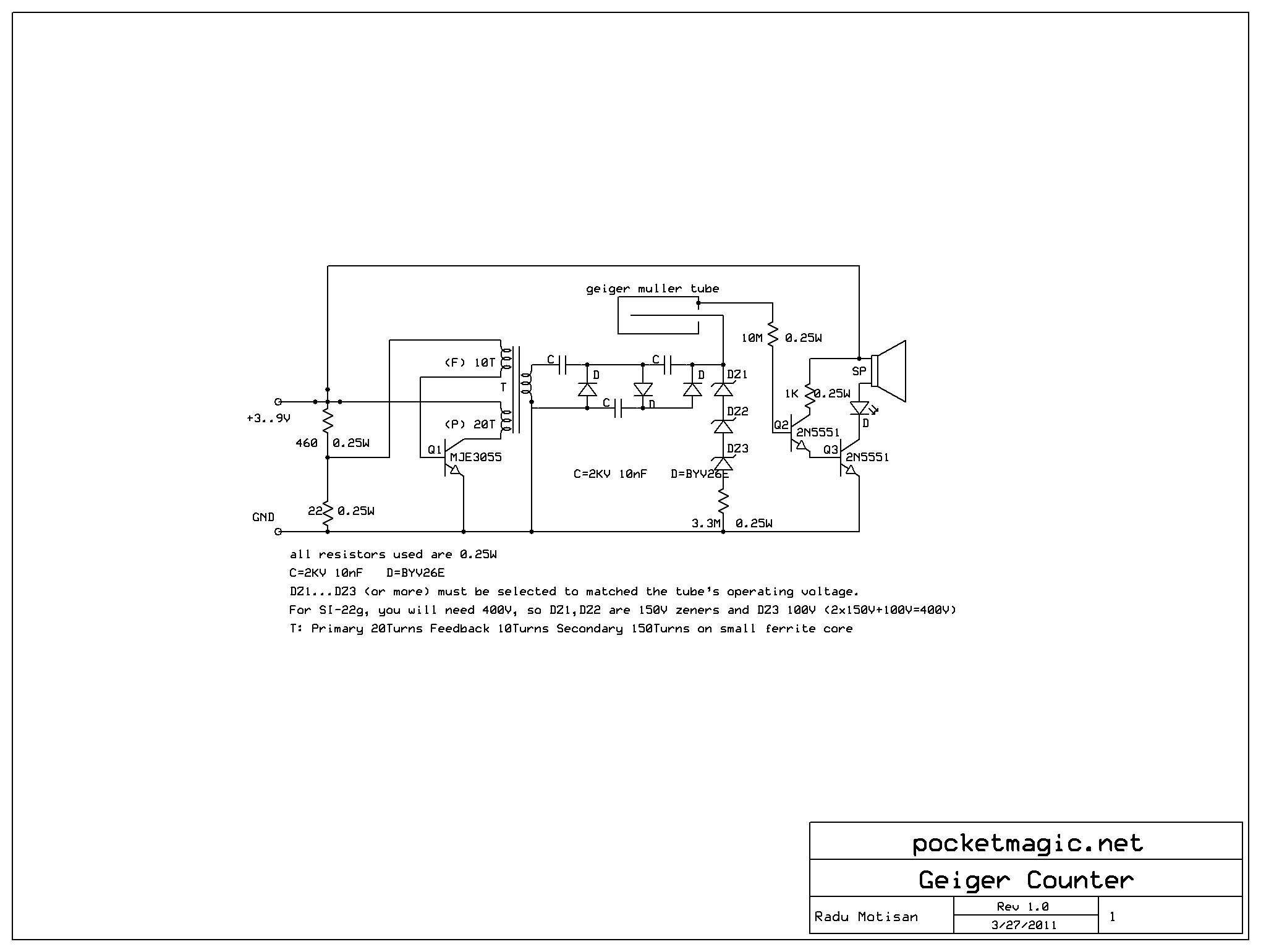
The recent events in Fukushima, Japan, raised significant concerns regarding radiation levels. In response to public demand, a simple Geiger-Muller counter has been designed using the Russian tube SI-22G and a single transistor-regulated inverter that outputs 400V, which is essential for operation. The entire setup can be assembled in approximately five minutes, making it a straightforward detector. It offers excellent sensitivity, indicated by an LED and a small speaker. Each pulse, represented by the flashing LED and clicking sound, corresponds to a radiation quantum passing through the tube. A small radiation source, the Eii-43-100 Spark Gap radioactive tube containing less than 0.9 µC of Cs137, emitting approximately 1 µSv/h of gamma radiation, was used for demonstration. The detector responds promptly to the presence of the Spark Gap tube, with the frequency of clicks increasing significantly above the background level. This design can accommodate a variety of Geiger tubes, although adjustments to the output voltage and limiting resistor may be necessary. For the SI-22G, specific parameters must be followed. To correlate the clicks with the actual radiation dose, a Radex RD1706 dosimeter was placed near the homemade Geiger setup and the radioactive spark gap. This Geiger counter circuit features a regulated high voltage supply with adjustable output and can operate on a single AA battery (1.5V). Various Geiger tubes, including BG-08, G21H, SI22G, SBM19, and SI14G, have been tested with this device. The transformer for this circuit was designed with specifications of P=20, F=10, S=150, but the oscilloscope only showed 45 volts peak at 188 kHz when connected to the secondary output. A second transformer was constructed with P=25, F=25, S=290, yet still yielded insufficient voltage, measuring 92 volts peak at 80 kHz.
The Geiger-Muller counter circuit described utilizes a high-voltage inverter to achieve the necessary voltage for Geiger tube operation. The SI-22G tube requires a regulated supply of 400V, which is generated by the inverter circuit. The inverter is powered by a single AA battery, making the device portable and convenient for field use. The circuit is designed to be user-friendly, allowing for quick assembly and operation.
The output from the Geiger tube is processed through a pulse detection circuit that activates an LED and a speaker. The LED provides a visual indication of detected radiation, while the speaker emits a clicking sound for auditory feedback. Each pulse corresponds to an ionizing event detected by the tube, allowing users to understand the intensity of radiation in their environment.
The versatility of the design permits the use of various Geiger tubes, provided that the voltage and resistor values are adjusted accordingly to match the specifications of the selected tube. This adaptability is crucial for users who may have access to different types of Geiger tubes and need to ensure optimal performance.
To further enhance the functionality of the Geiger counter, it is recommended to calibrate the device using a reliable dosimeter like the Radex RD1706. This calibration process will help users establish a correlation between the click frequency and the actual radiation dose, providing a more accurate assessment of radiation levels.
In conclusion, this Geiger-Muller counter circuit presents a practical solution for radiation detection, combining simplicity of design with effective performance. The ability to operate on a low power supply and the rapid assembly make it an attractive option for hobbyists and professionals alike, ensuring that users can monitor radiation levels effectively and efficiently.Because the recent events in Fukushima, Japan, brought a lot of concern on radiation levels, by popular demand, here is a simple Geiger Muller counter using the Russian tube SI-22G and a single transistor regulated inverter that puts out 400V, as required. The complete setup has been assembled in only 5 minutes, so this is a very simple detector, but can prove useful because of the excellent sensitivity: The radiation is indicated by a led and a small speaker. Each pulse (flashing led and the clicking sound) represents a radiation quantum passing through the tube.
To exemplify I`ve used a small source of radiation, the Eii-43-100 Spark gap radioactive tube, containing less than 0. 9uC of Cs137, emitting aprox. 1uSv/h of gamma radiation. The detector reacts promptly to the presence of the Spark Gap tube, the frequency of clicks increases, much over the background level.
This design can be used with a large variety of Geiger tubes, but the output voltage and the limiting resistor might need to be adjusted accordingly. For the SI-22G, the parameters are: To get an idea on a correlation between the clicks and the real radiation dose, I`ve placed the excellent Radex RD1706 dosimeter close to the homemade geiger setup and the radioactive spark gap: [.
] By Radu Motisan Posted on January 8th, 2012 This geiger counter circuit features a regulated high voltage supply, with adjustable output. It can run on a single AA battery (1. 5V). The video shows several geiger tubes tested with this device: BG-08, G21H, SI22G, SBM19, SI14G Circuit diagram v3.
1: SCH File (ExpressSCH): geiger_clicker_2 You can view the previous article on DIY geiger counters here. [. ] I build the transformer for this circuit (P=20, F=10, S=150) but my oscilloscope shows only 45 volts peaks 188 Khz when connected to the secondary output of my transformer.
I though i made a mistake when i build the transformer so i build another one (P=25, F=25, S=290). I still do not have enough voltage = 92 volts peaks 80 Khz 🔗 External reference
The Geiger-Muller counter circuit described utilizes a high-voltage inverter to achieve the necessary voltage for Geiger tube operation. The SI-22G tube requires a regulated supply of 400V, which is generated by the inverter circuit. The inverter is powered by a single AA battery, making the device portable and convenient for field use. The circuit is designed to be user-friendly, allowing for quick assembly and operation.
The output from the Geiger tube is processed through a pulse detection circuit that activates an LED and a speaker. The LED provides a visual indication of detected radiation, while the speaker emits a clicking sound for auditory feedback. Each pulse corresponds to an ionizing event detected by the tube, allowing users to understand the intensity of radiation in their environment.
The versatility of the design permits the use of various Geiger tubes, provided that the voltage and resistor values are adjusted accordingly to match the specifications of the selected tube. This adaptability is crucial for users who may have access to different types of Geiger tubes and need to ensure optimal performance.
To further enhance the functionality of the Geiger counter, it is recommended to calibrate the device using a reliable dosimeter like the Radex RD1706. This calibration process will help users establish a correlation between the click frequency and the actual radiation dose, providing a more accurate assessment of radiation levels.
In conclusion, this Geiger-Muller counter circuit presents a practical solution for radiation detection, combining simplicity of design with effective performance. The ability to operate on a low power supply and the rapid assembly make it an attractive option for hobbyists and professionals alike, ensuring that users can monitor radiation levels effectively and efficiently.Because the recent events in Fukushima, Japan, brought a lot of concern on radiation levels, by popular demand, here is a simple Geiger Muller counter using the Russian tube SI-22G and a single transistor regulated inverter that puts out 400V, as required. The complete setup has been assembled in only 5 minutes, so this is a very simple detector, but can prove useful because of the excellent sensitivity: The radiation is indicated by a led and a small speaker. Each pulse (flashing led and the clicking sound) represents a radiation quantum passing through the tube.
To exemplify I`ve used a small source of radiation, the Eii-43-100 Spark gap radioactive tube, containing less than 0. 9uC of Cs137, emitting aprox. 1uSv/h of gamma radiation. The detector reacts promptly to the presence of the Spark Gap tube, the frequency of clicks increases, much over the background level.
This design can be used with a large variety of Geiger tubes, but the output voltage and the limiting resistor might need to be adjusted accordingly. For the SI-22G, the parameters are: To get an idea on a correlation between the clicks and the real radiation dose, I`ve placed the excellent Radex RD1706 dosimeter close to the homemade geiger setup and the radioactive spark gap: [.
] By Radu Motisan Posted on January 8th, 2012 This geiger counter circuit features a regulated high voltage supply, with adjustable output. It can run on a single AA battery (1. 5V). The video shows several geiger tubes tested with this device: BG-08, G21H, SI22G, SBM19, SI14G Circuit diagram v3.
1: SCH File (ExpressSCH): geiger_clicker_2 You can view the previous article on DIY geiger counters here. [. ] I build the transformer for this circuit (P=20, F=10, S=150) but my oscilloscope shows only 45 volts peaks 188 Khz when connected to the secondary output of my transformer.
I though i made a mistake when i build the transformer so i build another one (P=25, F=25, S=290). I still do not have enough voltage = 92 volts peaks 80 Khz 🔗 External reference
